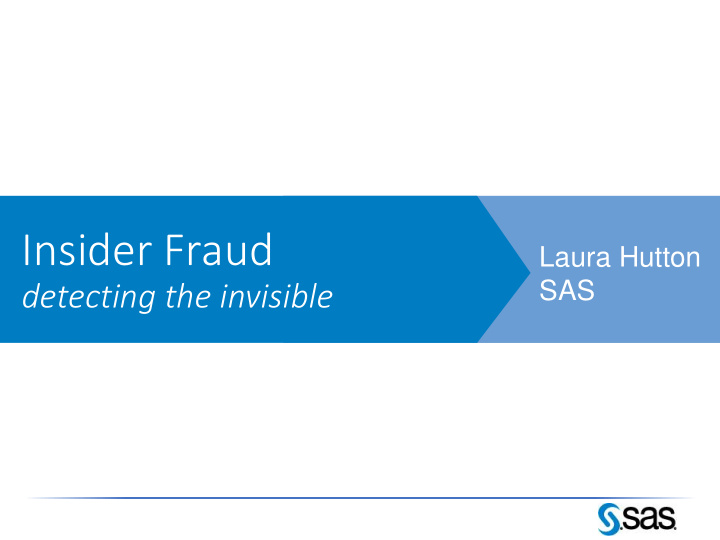



Insider Fraud Laura Hutton SAS detecting the invisible
The new fraud landscape & the rise of the insider How to rob a bank How to detect fraudulent staff
Fraud is a global problem Typical organisations lose 5% of revenues Source: Association of Certified Fraud Examiners to fraud each year Estimated to be a global loss of more than $3.5 trillion Industries most commonly victimised: • Banking & Financial Services • Government and Public Administration • Manufacturing Sector
Tough challenges for organisations The global AML market is Potential projected global Estimated global financial currently at $450 million fraud losses related to crime IT spending will grow USD, will grow at a CAGR of occupational fraud are more to $4.3 billion USD by 2013. 9%, reaching $690 million than $3.5 trillion USD. Chartis Research USD in 2015 . ACFE 2012 Report to the Nations Aite Group 2011 “ Cyberthieves have cost US In the UK , estimates show Tax evasion losses are companies and their banks that 55% of fraud – a estimated at $3.1 trillion for more than $15 billion in the massive £21 billion – is 145 countries in the world past five years , the FDIC committed against the which represent 98% of the found in a recent study.” public sector . world GDP between them. National Fraud Authority Financial Times, 2012 The Tax Justice Network Organisations are faced with tough challenges to focus on reducing losses AND ensure a smooth customer journey AND take effective, timely action.
Today’s frauds are Increasingly sophisticated Higher velocity/faster Cross industry Multi channel Advanced technologies Social with pressures on staff
Current fraud systems are not good at finding insiders: Siloed by line of business - No sharing of data Act on event or customer Rules and predictive models alone have limitations Few proactive steps taken to combat cross channel fraud Evidence insufficient to act upon Investigation time consuming
Today’s schemes are Internal fraud and collusion are on the rise
Why is insider fraud so hard to spot ?
Statistics 75% of all 75% major fraud cases involved insiders KPMG Australia 2012 survey
Financial losses Today’s schemes are Reputational Risk
Would make a Real Fraud terrible heist movie!
How to rob a bank
The perfect heist requires: • Advanced safe cracking • Mountain climbing • Kung Fu • Computer hacking • CCTV hacking …
Or …
Get a job at the bank … … or better still
Get to know someone who has a job at the bank
Insider fraud is the low risk, high reward crime of choice for modern organised criminals
80% Mortgage fraud How many mortgage fraud cases involved collaboration with industry insiders? The FBI Estimate, Washington Post, Dec 11
What is internal ‘fraud’? Stealing money from a dormant customer Searching account Favouring for applications information of use to a from a competitor friend Searching Giving the account themselves of a credit to favourite cover debts team
Intervention strategy is key to success
How to detect staff Fixing Fraud behaving badly
Avivah Litan, VP Gartner How to detect staff "Security and fraud risk exposure is increasing as organizations are Fixing Fraud behaving badly threatened at multiple points of vulnerability. Companies are re-evaluating how they tackle security since a fragmented approach is consistently leaving organizations at greater risk of attack. A more holistic approach to security ensures all layers of protection function together .“
Detection 3 step programme
Step 1 Train your staff to spot the signs of social engineering and Organised Crime recruitment.
Step 2 Recognise that none of your external fraud detection systems are likely to find an insider – they already have the keys to the safe!
Step 3 Adopt a holistic “defence in depth” approach to the problem. Identify data sources that will enable you to distinguish staff behaviour.
Make better use of your data Network Entity Event
Understand the risks Theft from customers Data theft Credit Abuse Expenses & Breaches of Payroll policy Money Trading fraud laundering Procurement fraud
Hybrid Analytics
Hybrid Analytics SAS Fraud Framework The fraud threat landscape
SAS Fraud Analytics Reduce reputational risk Through more accurate identification of high risk employees Reduce exposure to operational risk and fraud committed by employees More suspicious cases identified Fraud identified earlier Reduction in false positive rates Improved investigation efficiency Create extensible solutions Fraud grows and changes over time - your solutions need to be able to evolve faster
Demonstration
Questions & Answers
For further information WWW.SAS.COM
Recommend
More recommend